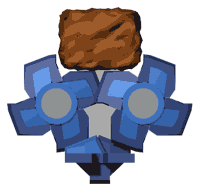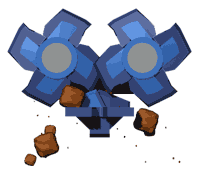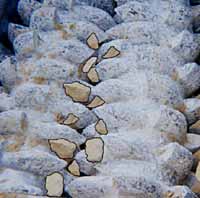Unique Principles of Sizer Technology
The unique principles of SIZER TECHNOLOGY are incorporated in the MMD SIZER. Whilst the application of these  principles produces a simple, robust and compact machine; the breaking action is very complex.
principles produces a simple, robust and compact machine; the breaking action is very complex.
Initially developed for underground applications, the MMD Twin Shaft Mineral Sizer had to be capable of processing high volumes of material in a compact and reliable design. These parameters are also a great advantage in any plant design but produce the highest returns when used for Mobile or Semi-Mobile installations. The fact that the breaking forces are all contained within the framework of the machine is also a great advantage from the construction standpoint, allowing a simple support structure even in a static application.
THE PRINCIPLES OF SIZER TECHNOLOGY
The basic concept of the Sizer is the use of two rotors with large teeth on small diameter shafts driven at low speed by a direct high torque drive system. This design produces the three major principles which all interact with each other when breaking materials using SIZER TECHNOLOGY. The three unique principles are:
• The Three-Stage Breaking Action
• The Rotating Screen Effect.
• The Deep Scroll Tooth Pattern.
1. THE THREE-STAGE BREAKING ACTION1.1 The First Stage of BreakingThis takes place as the large rotor teeth grip the material as it falls on to the shafts. These teeth subject the rock to multiple point loading, which induces stress into the lump causing any natural weakness present in the material to be exploited. |
|
1.2 The Second Stage of Breaking.The secondary breaking, takes place close to the centre line of the rotor, where the three point loading created between the top face of the tooth on one rotor and the top of the two opposing teeth on the other rotor, induces tensile stress in the rock. As the tensile strength of most materials is approximately 10% of the compressive strength, it reduces the amount of power consumed at this stage. |
|
1.3 The Third Stage of Breaking.Fitting a breaker bar below the centre line of the rotors allows any over size lumps carried by the scroll through the rotors to be broken, again exploiting the weaker tensile strength of the material. The breaker bar, which forms a comb through which the rotor teeth have to pass, can be adjusted up or down to modify the product size. |
|
|
|
|
2. The Rotating Screen EffectThe interlaced toothed rotor design allows free flowing undersize material to pass through the continuously changing gaps generated by the relatively slow moving shafts. Undersize material fed to the Sizer or produced during the first and second stages of breaking flow through the rotors with the assistance of gravity and the constant agitation caused by the rotating shafts. If the machine is fed from one end, this feature gives the added benefit that the smaller material is deposited on the belt first followed by the larger material forming a sealing layer above the dust giving environmental benefits on conveyor systems. |
|
3. The Deep Scroll Tooth Pattern
The deep scroll conveys the larger material to one end of the machine and helps to spread the feed across the full length of the rotors. This feature can be used to reject oversize material from the machine. |
|
There are obviously other contributing factors in the breaking and passing of material through the Sizer, which have yet to be quantified, and most of the development work is done in the field by carefully selecting opportunities which widen the range of materials that are handled by MMD SIZERS. This programme of application-based development has driven the rapid advance of Sizer Technology and produced a wide variation of proven designs which can be applied to future projects. This practical approach is complemented by sponsored university study and the application of the latest computer technology in design and analysis of the forces that the equipment has to withstand.
MATERIALS HANDLED
As described in the approach above, MMD SIZERS have proved that they can handle a large variation of materials. An outstanding feature of these machines is their ability to handle very wet sticky and hard material either separately or together through the same unit. The changes required for the sticky material can be simply incorporated at the manufacturing stage and many can be added to existing machines if the material to be handled is changed.
Source: http://www.mmdsizers.com/products/sizers/principles.php

|




